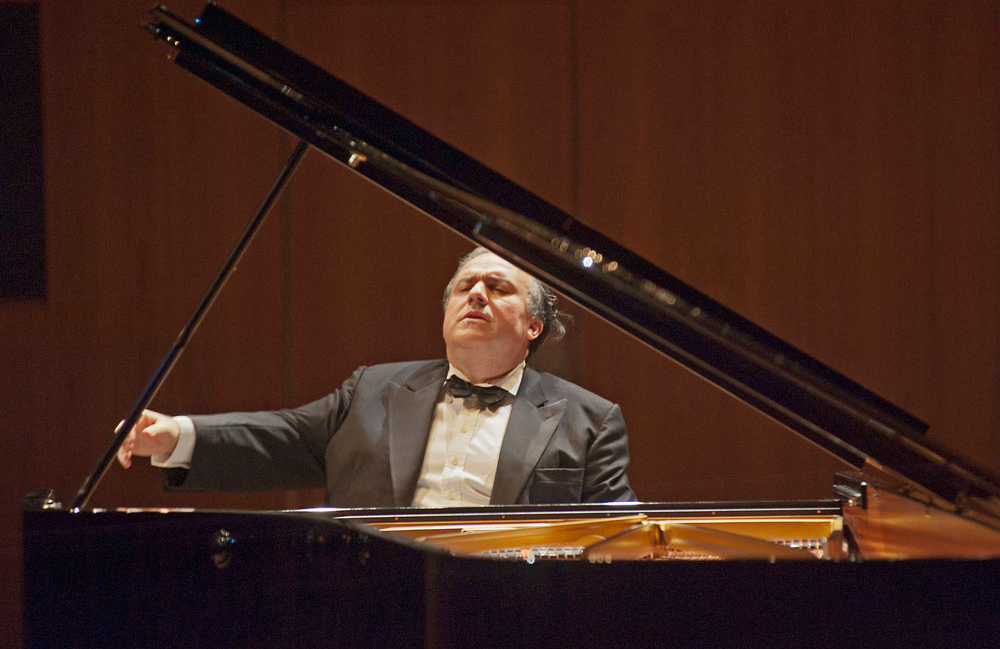Bronfman turns inward for mostly understated program

Yefim Bronfman performed Tuesday night for Washington Performing Arts.
Pianist Yefim Bronfman last performed locally to mark the 50th anniversary of Shriver Hall in Baltimore. He is known for bravura thrills in hard-edged repertoire, but at that time he gave a performance that went beyond subtlety almost into reticence. His latest appearance under the auspices of Washington Performing Arts, heard on Tuesday night at the UDC Theatre of the Arts, produced a similar effect.
One does not generally wade into a Bartók piece, especially the Suite for Piano, op. 14, looking for a delicate touch. Bronfman’s approach to this rhythmically charged explosion of accents and stinging dissonance was neither fast nor especially barbaric in style. Recalling his writing of this piece in 1916, Bartók later said he “had in mind the refining of piano technique,” to transform it into “a style of bone and muscle.” In that light Bronfman’s emphasis on nuance, although whimsical and beautiful at times, seemed misplaced.
Schumann’s Humoreske, last heard from Benjamin Grosvenor in 2014, is a difficult piece to pull off in performance. Schumann once called it his “most melancholy composition,” saying that while creating it he was “both laughing and crying.” One of Schumann’s favorite authors, Jean Paul, inspired that combination of sentiments, and Bronfman’s gift for elegant distinction of interior voices made the slow sections of this piece into polished cameos. The contrast with the faster sections was not always strong enough, although the concluding heroic section was heroic and forthright.
In the second section of this piece, marked “Hastig,” Schumann, eccentrically, notated a third staff between the two hands. Marked “innere Stimme” (inner voice) and written in small notes is a melody on the bass clef, essentially in a high male voice. It is not meant to be performed, just heard in an interior way, but every time the piece appears on a concert program, one wonders if a pianist might sing the line or have it played offstage by another instrument. Although it would be a memorable effect, those hopes were dashed again this time around. The right hand shadows this hidden tune for the most part, but it is not the same.
On the second half, Debussy’s Suite bergamasque was the least effective work of the evening, a performance not drenched in color but rather vanilla. The famous “Clair de lune” movement featured more of Bronfman’s finely tooled details of touch, but little about the interpretation showed much depth of engagement. He rushed through the first and last movements without much thought, and the “Menuet” lacked interest beyond a slightly comic tinge.
This was decidedly not the case with the Three Movements from Petrushka, which Bronfman dashed off with virtuosic panache and a profound understanding of the ballet choreography behind the musical gestures. The octaves and planing chords were ruthlessly accurate, and Bronfman distilled the chaotic sections rife with overlapping parts into crystalline layers.
For a single encore, Bronfman turned back to Schumann, the Arabeske, op. 8, which turned out to be one of the evening’s high points. Here was the lyrical line that could have connected the disparate parts of Humoreske and the Suite bergamasque in a more convincing way.
Next week Washington Performing Arts hosts a duo piano recital by Leif Ove Andsnes and Marc-André Hamelin 8 p.m. Monday in the Music Center at Strathmore. washingtonperformingarts.org; 202-785-9727.
